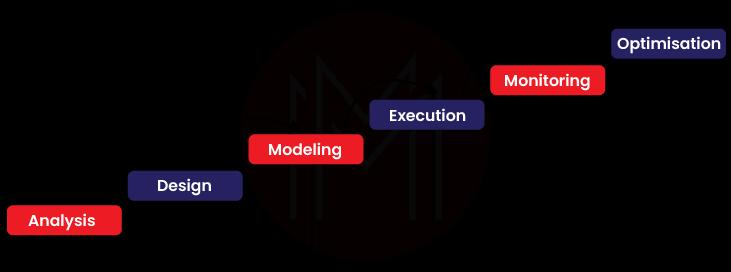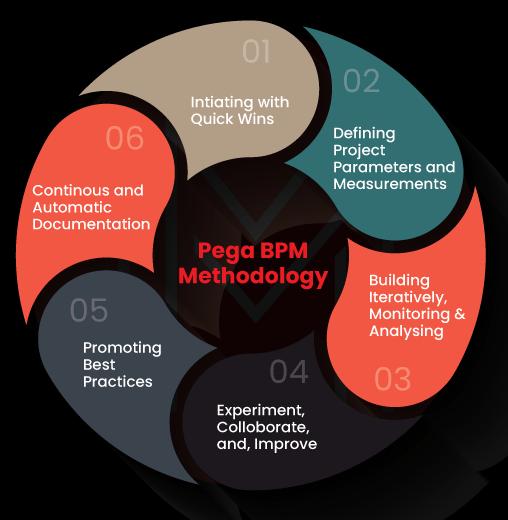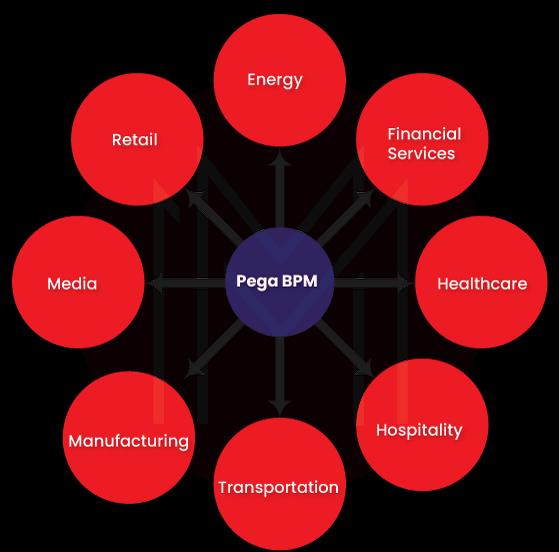Pega is a well-known company offering automation solutions to all types of businesses. Pega is one of the industry leaders in offering the best BPM solutions to medium and large-scale industries. Their forefront is very simple; they offer dynamic BPM solutions rather than traditional static BPM solutions.
In this blog, you will walk through BPM and its features, Pega BPM and its methodology, Pega BPM and case management, etc. – everything in detail.
| Table of content - Pega BPM |
What is BPM?

BPM - Business Process Management is the systematic approach to enhancing business processes by creating effective business process models. The process models are designed by analysing the end-to-end business processes, defining proper workflows, and streamlining processes effectively. Also, BPM is the continuous activity in which the performance of business models is continuously monitored, and improvements are further added to ensure business consistency.
Why BPM?
Businesses that wish to be competitive in today’s breakneck speed market can implement BPM techniques into their processes to optimise them. Know that BPM solutions are innovative and easy to implement. So, it helps to remove chaos in workflows and processes and optimises them to reach their best. As a result, business agility and visibility over the processes increase, enhancing overall performance and efficiency. In the end, it tends businesses to bring out better products and offer excellent services to their customers, increasing the business value.
| If you want to enrich your career and become a professional in Pega, then visit Mindmajix - A global online training platform: "Pega Online Training" This course will help you to achieve excellence in this domain. |
What is BPM Methodology?
BPM methodology is the systematic procedure to develop and implement BPM solutions for businesses. Let’s know how to design an effective BPM model and implement it in businesses from the following:
Analysis: Initially, the processes and workflows in the business are analysed, and the suitable processes are identified for optimisation.
Design: There are three kinds of workflows in a business in today's scenario. They are human-to-human, system-to-system, and human-to-system. The design of the BPM model must be in a way that it has to reduces errors in workflows and processes to the least. Also, the design must sync with the business's Standard Operating Procedures (SOP).
Modeling: In this stage, different inputs are applied to the model to identify the possibilities of errors and then improvise the BPM model by removing the errors proactively.
Execution: This is the deployment and execution stage in which the designed BPM model is executed in real-time.
Monitoring: The BPM model continually tracks the performance KPIs, errors in the processes, and compliances with set standards. Also, the prediction capabilities of the BPM model identify the potential problems well in advance by tracking the workflows and processes.
Optimisation: At this stage, data of all the processes and workflows are analysed thoroughly to rectify errors to increase performance and improve business outcomes.
Related Article: BPM Tools
What is Pega BPM?
First of all, we will look at what Pega is. Pega is the low-code process automation software platform. According to Forrester Report (Q4 - 2021), Pega is named one of the leaders in process automation software.
Can you guess why Pega is being quite popular in automation software development?
Pega supports building software applications quickly and offers end-to-end customer experience effectively. In addition, Pega provides the best solutions for case management, content management, security of resources, and application development.
This way, Pega BPM is the BPM solution offered by Pega. Pega BPM is the cloud-based automation tool developed based on Java and Object-Oriented Programming concepts. It supports you in simplifying and automating business processes. And it supports to development and deployment of BPM software very quickly. The most crucial aspect of Pega BPM is that it is dynamic nature – it means that changes in the business processes are quickly adjusted into the process model, and the automation software is capable of adapting to the changes on the fly. Here, the changes can occur in the form of diverse customers, channels, product lines, locations, and so on.
What’s more! Pega BPM can automate business operations such as case management, business rules, mobile application development, reporting, security, integration, and predictive and adaptive analytics. Pega BPM allows automating primary business services such as sales, marketing, accounts, and other services on similar tracks. Know that Pega BPM is that it can be employed in the Cloud and on-premises.
Also Read: Pega Tutorial
Why Pega BPM?
Primarily, Pega BPM is a faster tool than the other similar tools. If you astonish at how Pega BPM is faster when compared with other tools, we will help you with the correct data. Know that Pega BPM is 40 percent faster in mobile application development than similar tools, eight times faster in making analyses and creating designs, and eight times faster in making changes in the process models. That’s why Pega BPM is being increasingly used by enterprises to optimise their business processes and achieve business outcomes. There is no surprise that Pega BPM could be the favourite tool for employers as it reduces operational costs and accelerates business agility.
Related Article: What is Pega Frameworks
What are the Pega BPM Features?
Automatic Code Generation: Pega BPM can generate application codes automatically, which in turn, reduces the programming time of developers significantly. It has industry-specific solution frameworks that use less technical syntax for developing Pega applications. Also, Pega BPM allows you to develop applications through visual tools, which helps even business users to modify the process models securely. Moreover, this feature supports converting complex business processes into simple but effective processes.
Pega Omni-channel UI: Pega BPM User Interface (UI) is the kind of design-once and deploy-anywhere model. So, any channel can be interfaced with the Pega UI, whether it is a mobile or tablet. The screen size can be adjusted according to the parameters such as device, user, or channel. As Pega UI is a standards-based UI, it reduces time and costs to the least.
Pega Live-Data: This feature integrates all the data of the entire business processes, analyses them, and consolidates them into simple formats for presentation. Therefore, it paves the way to deliver the correct data to the right people at the right time. The crucial thing about Pega live-data is that it has the caching option, which helps to improve data management by reducing the load on external applications. Moreover, Pega live-data has the features such as loose coupling and presentation layers, which allow flexible changes to be made to data sources.
Adaptive Decision Management: This feature allows you to make crucial decisions with the support of big data analysis concepts. And the decisions can be taken at any time for any business scenario – considering the dynamic changes in the processes. Additionally, this feature supports retrieving data automatically to make decisions in real-time quickly.
Pega Situational Layer Cake: This feature of Pega BPM supports adjusting business processes with respect to the changes in customer type, products, departments, channels, geographies, time, and languages.
Pega Pulse: This feature is a kind of social collaboration of Pega BPM, which allows employees, partners, and customers to solve problems in their efforts and, at the same time, ensuring the security of the resources.
Read Related Article: Pega Interview Questions and Answers
What is the Pega BPM Methodology?

Pega BPM methodology consists of various steps to design robust BPM models, develop the software, deploy and execute, and optimise the models using an iterative method. Let's get into the steps right away:
Initiating with Quick Wins: The implementation of Pega BPM for a business starts from identifying the simple processes that can be automated both initially and quickly. This is because the initial quick wins turn into a motivational factor for developers and employers to automate all potential business processes subsequently.
Defining Project Parameters and Measurements: This stage involves Pega BPM Application Profiler, which helps to define project goals, use-cases, and the related processes that can be automated. This must be done by discussing the project with all the people involved. Additionally, the measurement methods are defined in this stage to precisely scale the performance of automated processes.
Building Iteratively: The prime aspect of Pega BPM model development is implementing the iterative method. During the testing phase, the application codes are tested iteratively. As a result, the BPM software is created, reducing the maximum of errors.
Monitor and Analysis: After the deployment, the measuring parameters, such as KPIs, workflows reports, etc., are monitored to track the behaviour and performance of processes. So, you can identify the areas to be improved and modify the processes suitably.
Experiment, Collaborate, and Improve: Once you have modified or adjusted the processes, you can execute the processes again to witness the incremental improvements. Implementing collaborative methods in every BPM model development process will help improve the process performance to its best. For that, you need to include all the stakeholders involved in the project in all phases to avoid mismatches and achieve continuous improvement. Very importantly, customers need to be adequately trained to familiar with the automation tools, which will indeed result in increased performance.
Promoting Best Practices: The best practices support optimising your BPM software in all possible ways. The best practices include choosing the right processes and tools, and setting achievable automation goals. It also includes defining roles and workflows accurately involving all the stakeholders to ensure continuous improvement.
Continuous and Automatic Documentation: Pega BPM ensures the continuous and automatic generation of documents in parallel with the flow of business processes.
What is Case Management, and why is it required?
First of all, let’s now know what a case is. A case is nothing but a task to be completed by coordinating many processes. It is a software-based approach applied to gather, orchestrate, and monitor data to complete a task and meet the desired business outcomes. In other words, a case has the intelligence to retrieve the right information, execute and detect changes in processes, escalate deviations and alerting, and take decisions. The prime aspect of a case is that it syncs with the dynamic changes in business processes.
When considering case management, primarily, it supports performing ad-hoc works very effectively. Know that it is the software that has the graphical models to design process stages down to individual tasks level. Case management ensures real-time and consistent reporting to stakeholders to make informed decisions. Also, insights generated from case management will help identify manual processes in the business that can be automated to enhance business growth.
The Automation capability of case management supports coordinating various planned and unplanned activities accurately. ’Design by doing’ is the highlight of case management in which process models can be designed while doing work and updating the automation software accordingly.
Pega BPM and Case Management
Know that Pega BPM is the combined tool that integrates Business Process Management (BPM) and Robotic Process Automation (RPA) in a single platform. This combo involves organising work, automating processes, and making smarter decisions using bots. With Pega BPM and case management, you can eliminate silos in business processes and simplify complex processes, ensuring flawless business processes. Also, it supports ensuring regulatory compliances, minimising compliance risks, and performing self-documentation to the least. So, overall, it increases business efficiency to its maximum.
Enterprises that leverage Pega BPM
The below image will show you what industries can best adopt Pega BPM to boost their business growth.

Benefits of Pega BPM
Aside from its dynamic response to changes in processes, Pega BPM has many benefits. Let's consolidate the benefits of Pega BPM as follows:
- Supports you in building applications faster so that business objectives can be converted into executable processes quickly
- Optimises customer interactions through UI, and automatically tailors screens and forms to improve user experience. This, in turn, improves customer engagement and accelerates business growth.
- Pega BPM can be moved from the Cloud to Datacenter, and vice-versa
- Minimises reliance on IT staff and reduces the cost of maintenance
- Ensures security and stability, improves business agility, and achieves flexible scaling with dynamic business changes
- With flexible UI, users can just switch from desktops to tabs or mobiles, and vice-versa at any time and anywhere
- Above all, it satisfies regulatory compliance requirements and ensures secured business processes.
[Related Article: Pega Integration]
Conclusion
Now, we have come to an end. Keeping the above-discussed points in mind, we can realise that Pega BPM is the tool that optimises business processes and enhances business agility to peaks. Remember, the motto of Pega BPM is straightforward – build for change. Changes in the processes are adjusted or updated in BPM software as and when they occur. This dynamic nature of Pega BPM makes its differentiation from others. Lastly, Pega BPM and case management derive excellent results from the business operation, reducing time and cost significantly.
 On-Job Support Service
On-Job Support Service
Online Work Support for your on-job roles.

Our work-support plans provide precise options as per your project tasks. Whether you are a newbie or an experienced professional seeking assistance in completing project tasks, we are here with the following plans to meet your custom needs:
- Pay Per Hour
- Pay Per Week
- Monthly
| Name | Dates | |
|---|---|---|
| Pega Training | Dec 23 to Jan 07 | View Details |
| Pega Training | Dec 27 to Jan 11 | View Details |
| Pega Training | Dec 30 to Jan 14 | View Details |
| Pega Training | Jan 03 to Jan 18 | View Details |

Madhuri is a Senior Content Creator at MindMajix. She has written about a range of different topics on various technologies, which include, Splunk, Tensorflow, Selenium, and CEH. She spends most of her time researching on technology, and startups. Connect with her via LinkedIn and Twitter .













